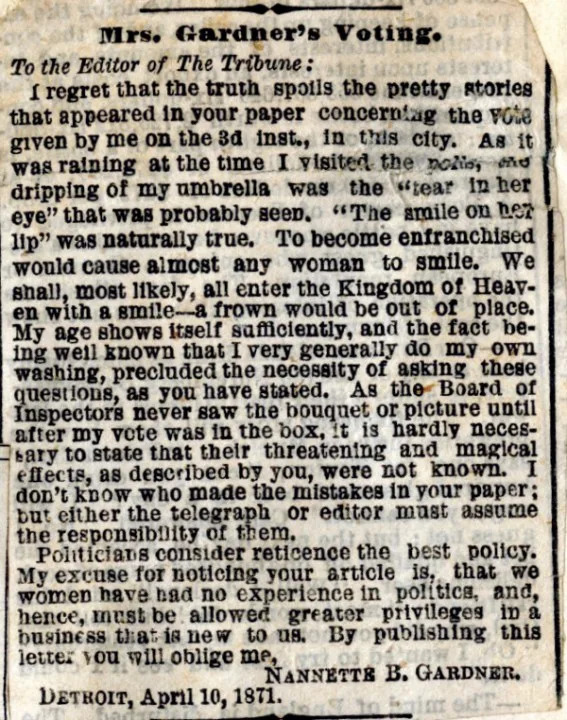
GRAND RAPIDS, Mich. (WOOD) — Aug. 20, 1920, is a big date in American history. It marks the day Tennessee ratified the 19th Amendment, giving women across the country the right to vote.
While Tennessee was the 36th state to approve the law, triggering the three-quarters majority needed to amend the Constitution, Michigan was among the first. Illinois, Wisconsin and Michigan each ratified it on June 16, 1919.
Michigan wasn’t just on the front lines of women’s voting rights: It also was home to one of the few women who managed to vote between the American Revolution and the constitutional amendment.
Her name was Nannette Gardner. Her story isn’t well known, but it shows how at least one woman was able to take the system built to subdue her voice and use it to her advantage.
MEET NANNETTE
Nannette Ellingwood was born in 1828 in New Hampshire. Historians say she was raised in an abolitionist family and they helped African Americans fleeing slavery reach freedom in Canada. She kept that passion with her as an adult and was an outspoken advocate for ending slavery and advancing rights for women.
At some point, she made the move to Detroit. When she was 26 years old, she married a man named Miles T. Gardner, a well-to-do “seedsman” who owned a nursery and a large tract of land. Historical writer Amy Probst noted in Bentley Historical Library’s semiannual magazine that Gardner’s wealth “put (Nannette) in a position to devote more means and time to both abolition and suffrage.”
Unfortunately, Miles Gardner died in 1867, leaving his wife not only widowed with two children, but also with a nursery to manage and a giant tract of land that required annual taxes. Both a blessing and a curse, those assets ultimately paved the way for her to make a bit of history.
Ceiling shattered: Anna Bissell broke barriers as America’s first female CEO
As Probst noted, the U.S. Constitution guarantees equal rights for all citizens, but a lot of the minutiae is vague. It left room for state governments to shape laws to their liking. And unlike the chaotic years of the American Revolution, when there were many instances of women being allowed to vote, the new government was formed to be led by men and only men.
The 14th Amendment, which helped pick up the pieces from the Civil War, was written explicitly to include language that only granted “males” the right to vote. Michigan’s constitution, passed in 1835, didn’t help either. It was amended several times in the ensuing decades, but voting rights for women had yet to make the cut. As of 1871, the state only granted the right to vote to every male citizen over the age of 21 as long as they met residency requirements.
By law, Nannette Gardner was a land-owning taxpayer with no representation. So she took up the challenge and on March 25, 1871, she went to City Hall in Detroit to register to vote along with her good friend and fellow advocate Catharine Stebbins. Their registrations immediately caught the attention of the local board of inspectors, which scheduled hearings to rule on whether the two women should be allowed to vote.
The legacy of Eva McCall Hamilton, Michigan’s 1st woman in state legislature
Days later, Gardner and Stebbins got their chance to make their case. According to Probst, the women argued that language from the 1st and 14th amendments, even though they explicitly said “male,” should qualify them as citizens of the country and guarantee their right to vote.
Notably, the two women represented themselves in the hearings, instead of hiring male lawyers to speak for them.
“They argued with eloquence and approached their respective boards as equals,” Probst wrote.
It appears the board understood the disparity in the laws in the way they are written, but couldn’t blow the doors open to allow women to vote. They ultimately ruled against Stebbins because she had a husband who “could vote on behalf of her interests.” Since the widowed Gardner did not, the board, led by Alderman Peter Hill, voted 12-6 to keep her on the voting rolls.
ELECTION DAY
Though Stebbins was denied a ballot, she and her husband still escorted Gardner to the polls on Election Day. Details of that day have survived thanks to a journal entry from Gardner’s 13-year-old daughter, Sarah. (The journal was included when Nannette Gardner’s collection of papers was donated to the Bentley Historical Library.)
How tragedy led to Michigan’s first lady lightkeepers
“After Ma had deposited her vote she presented Mr. Hill a beautiful bouquet which was placed on the table near the box,” Sarah Gardner wrote.
The inscription read, “To Peter Hill, Alderman of the Ninth Ward of Detroit. By recognizing civil liberty and equality for (women), he has placed the last and brightest jewel on the brow of Michigan.”

The election was just another ho-hum decision for Detroit, but it was a banner day for the women’s suffrage movement. According to Sarah’s journal, days after the big vote, celebrated suffragette Susan B. Anthony visited with the Gardners on her way to and from another stop in Michigan.
“(Anthony) said that she could not rest contented until she had slept under the roof of the house of the first woman that had voted under the 14th and 1st Amendments,” Sarah wrote.
The story made headlines across the country. Gardner had no issue calling out newspaper editors who she believed misrepresented her story. A news clipping held in the library’s collection shows a letter she wrote to the Detroit Tribune in the week following her historic vote.
“I regret that the truth spoils the pretty stories that appeared in your newspaper concerning the vote given by me,” she wrote.
In another letter to the Detroit Post, Gardner wrote that she could not comprehend how a woman “expressing a choice among a few candidates for office should have caused such a commotion … (when) tens of thousands of vicious, ignorant and worthless men do the same thing yearly without a word of comment.”
Learn about Grand Rapids’ women legends through walking tour
According to Probst, Gardner continued to advocate for the women’s suffrage movement, befriending Anthony and fellow Michigander Sojourner Truth. Her story was also mentioned in the “History of Woman Suffrage,” a detailed volume edited by Anthony, Elizabeth Cady Stanton and Matilda Joslyn Gage.
Gardner remarried in 1873, but was again widowed the following year. She and her daughter eventually settled in Ann Arbor. She died in 1900 at 71 years old. Online records show Gardner is buried at Mount Hope Cemetery in Rochester, New York, the same cemetery as Anthony.
Copyright 2025 Nexstar Media, Inc. All rights reserved. This material may not be published, broadcast, rewritten, or redistributed.
For the latest news, weather, sports, and streaming video, head to WOODTV.com.








Comments